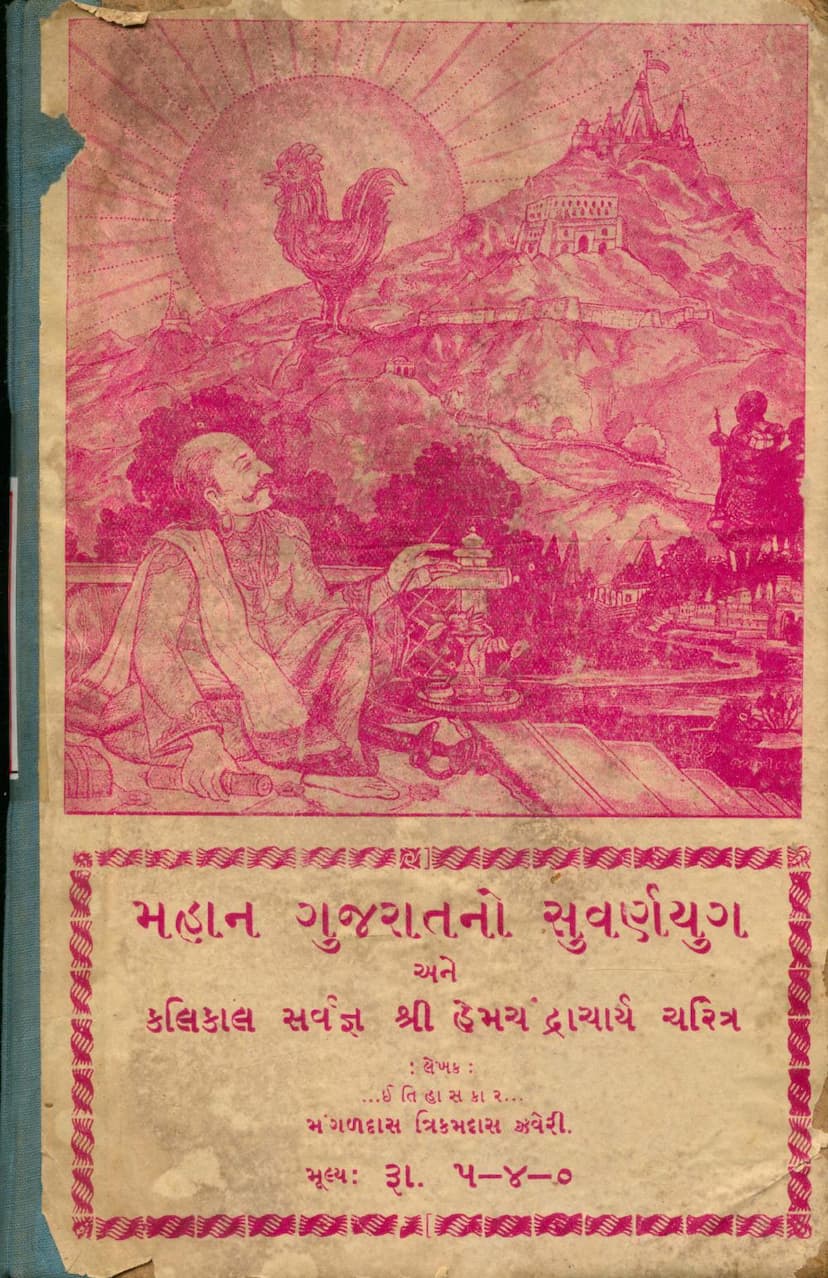Mahan Gujaratno Suvarna Yug Ane Kalikal Sarvagna Shree Hemchandracharya Charitra
Added to library: September 2, 2025

Summary
This is a comprehensive summary of the Jain text "Mahan Gujaratno Suvarna Yug ane Kalikal Sarvagna Shree Hemchandracharya Charitra" by Mangaldas Trikamdas Zaveri, based on the provided pages:
Overview:
The book, "Mahan Gujaratno Suvarna Yug ane Kalikal Sarvagna Shree Hemchandracharya Charitra" (The Golden Age of Great Gujarat and the Biography of the All-Knowing Hemchandracharya of the Kali Age), authored by Mangaldas Trikamdas Zaveri and published by Prachin Sahitya Sanshodhak Karyalay, aims to illuminate the glorious past of Gujarat, particularly during the era associated with the great Jain scholar Hemchandracharya. The text appears to be a historical and devotional work, focusing on the cultural, religious, and political landscape of Gujarat during a significant period.
Key Themes and Content:
The provided pages reveal a multifaceted exploration of Gujarat's history and Jainism's influence. The central themes include:
- The Golden Age of Gujarat: The book highlights a period in Gujarat's history characterized by prosperity, cultural flourishing, and strong religious devotion, particularly towards Jainism.
- Shree Hemchandracharya: The central figure of the book is the revered Jain scholar Hemchandracharya, described as "Kalikal Sarvagna" (All-knowing of the Kali Age). His life, teachings, and significant contributions are central to the narrative.
- Historical and Religious Narratives: The text delves into the history of Gujarat, tracing its lineage from the ancient past through various dynasties and significant events. It emphasizes the profound impact of Jainism and its acharyas on the region.
- Key Historical Figures and Events:
- Mahan Gujarat: The book extensively discusses the concept of "Mahan Gujarat" and its historical development.
- Chaulukya Dynasty: The era of the Chaulukya dynasty, particularly under rulers like Maharajadhiraj Siddhraj Jaysingh and Kumarapal, is prominently featured.
- Hemchandracharya's Influence: The narrative highlights Hemchandracharya's role in shaping the intellectual and spiritual life of Gujarat. His composition of the "Siddha-Hem Shabdanushasan" grammar, his influence on royal courts, and his profound philosophical insights are discussed.
- Jain Tirths and Temples: The book details the restoration and significance of important Jain pilgrimage sites and temples, notably the Shree Thana Navpadji Jinalaya. The artistic and architectural splendor of these places is emphasized.
- Biographies of Jain Acharyas: The text includes biographical sketches of various Jain acharyas and their contributions to Jain literature and philosophy, such as Shree Devchandracharya, Shree Virsuriji, and others.
- Social and Cultural Aspects: The book touches upon various social and cultural practices of the time, including the importance of trade, the role of merchants, and the influence of religious traditions on daily life.
- Jain Philosophy and Principles: The core tenets of Jainism, such as ahimsa (non-violence), the importance of the three jewels (Ratnatraya), and the pursuit of liberation, are woven into the historical and biographical accounts.
- The Jain Flag and Anthem: The inclusion of the Jain flag and its "Vandan Geet" (prayer song) by Chunilal Khimaji Karasiya suggests a focus on Jain symbols and their veneration within the community.
- Historical Research and Documentation: The author, Mangaldas Trikamdas Zaveri, is presented as a historian dedicated to researching and preserving ancient Jain literature. The publisher, Prachin Sahitya Sanshodhak Karyalay, is dedicated to this mission.
- Detailed Chapters: The table of contents (indicated by chapter titles) reveals a structured approach, covering the history of Gujarat, the birth and life of Hemchandracharya, his contributions, and the broader impact of Jainism on the region. Specific chapters are dedicated to the glories of Gurjar land, the life of Changdev, the significance of Vallabhpur, the importance of Jain philosophy, and the contributions of Jain acharyas to Gurjar literature.
Key Figures:
- Mangaldas Trikamdas Zaveri: The author and historian, dedicated to researching and presenting the history of Gujarat and Jainism.
- Shree Hemchandracharya: The central figure, a renowned Jain scholar and spiritual leader of immense influence.
- Siddharaj Jaysingh: The Chaulukya king who patronized Hemchandracharya and fostered the golden age of Gujarat.
- Chunilal Khimaji Karasiya: The author of the Jain flag anthem.
- Various Jain Acharyas: Mentioned throughout the text, highlighting their role in spreading Jainism and enriching its literature.
- Shree Thak" thana Navpadji Jinalay: The specific Jain temple that serves as a focus for some of the historical accounts and artistic representations.
Structure and Style:
The book appears to be a scholarly and devotional work, presenting historical events and religious teachings in an accessible manner. The inclusion of illustrations (as suggested by page 4) and detailed biographical and historical accounts indicates a commitment to providing a comprehensive understanding of the subject. The author's dedication to research is evident from the extensive list of references (page 28) and the emphasis on historical accuracy.
Overall Significance:
"Mahan Gujaratno Suvarna Yug ane Kalikal Sarvagna Shree Hemchandracharya Charitra" seems to be a significant contribution to Jain literature and the history of Gujarat. It aims to preserve and propagate the rich heritage of Jainism and its integral role in the development of Gujarat's golden age. The book serves as a testament to the enduring legacy of Hemchandracharya and the spiritual and cultural impact of Jainism on the region.